Babchuk vs Regehr, Part Two
A lot of people think that statistical analysis of hockey is complete nonsense, and last week we showed how these detractors appear quite justified when virtually every defensive statistic agrees that Anton Babchuk is as good as (or even better than) Robyn Regehr defensively.
We saw how these statistics appear to do a great job in determining the defensive strength of an entire team, but appear to be lousy at assigning those defensive contributions to the individual players. This week we’ll discuss an alternative way of assigning credit, apply it to the Calgary Flames defense for every season since the lock-out, and see if it passes the sniff test.
Assigning Defensive Contributions to Individuals
Having concluded last week that the 20.3 defensive point shares awarded to the Calgary Flames blue line in 2010-11 looks reasonable, how should it be assigned to the players individually?
• The simplest way is just to divide it up by ice-time, but that would mean that Jay Bouwmeester contributes just as much per minute as T.J. Brodie.
• Instead we could weigh it using something like +/-, but that has obvious flaws. Besides, his +18 score would still make Anton Babchuk look like the 2nd coming of Rod Langway.
• We could incorporate the type of advanced statistics that help put a player’s numbers in context, like Offensive Zone Starts and Quality of Competition, but now we’re getting awfully complex and inaccessible.
• Instead we could weigh it using something like +/-, but that has obvious flaws. Besides, his +18 score would still make Anton Babchuk look like the 2nd coming of Rod Langway.
• We could incorporate the type of advanced statistics that help put a player’s numbers in context, like Offensive Zone Starts and Quality of Competition, but now we’re getting awfully complex and inaccessible.
So what’s the easy solution? To me the key to assigning individual defensive contributions is based on something simple like ice-time, and avoids fancy statistics like Zone Starts and Quality of Competition, and I think we’ve got it.
The inspiration comes from Points Allocation – a system introduced by Iain Fyffe that actually pre-dates any of the methods discussed last week (GVT, PC , etc). Fyffe’s approach to assigning individual responsibility for a team’s over-all defensive success (or lack thereof) was based on the premise that any ice-time that can’t be explained by a player’s offensive contributions must be explained by their other contributions, the foremost of which is their defense. Brilliant!
An approach that would somehow peel the offensive component out of their ice-time would settle our sample controversy quite admirably. Check out how, at even-strength, Anton Babchuk outscored Robyn Regehr by almost double, 1.07 to 0.57 points per 60 minutes. Despite that clear superiority offensively, Robyn Regehr enjoyed far more ice-time at even-strength: 17.23 minutes per game to 12.98.
The Fix
All we need to do is figure out how much of a player’s ice-time was earned by their non-offensive contributions, and assign the team’s defensive contributions accordingly.
I’m not sure how Iain Fyffe does it, but I figure the most elegant way of approximating it is by adding:
• Their short-handed ice-time (which is defensive only)
• A percentage of their even-strength ice-time equal to the amount of all special teams time they spend short-handed
• Ignore their power play ice-time (which is offensive only).
• Their short-handed ice-time (which is defensive only)
• A percentage of their even-strength ice-time equal to the amount of all special teams time they spend short-handed
• Ignore their power play ice-time (which is offensive only).
At first I wrestled with a way to use their even-strength scoring to estimate what percentage of their even-strength ice-time was based on their defensive contributions, but it was complicated, subject to a lot of scoring luck, and wound up being quite similar to a player’s special teams time anyway.
Here’s how it looked for all Flames defensemen in 2010-11.

Much better! The two systems largely agree, but give defensive-minded blueliners like Robyn Regehr, Cory Sarich and Brendan Mikkelson a bit of a boost at the expense of offensive-minded defensemen like Anton Babchuk and Mark Giordano, while leaving two-way defensemen largely untouched. Unfortunately the new system doesn’t allow for negative defensive value, so last year that helped T.J. Brodie and Ian White.
These final results look surprisingly reasonable given the quick and dirty nature of the approach. Obviously a more sophisticated approach to the even-strength ice-time percentage could fine-tune this further, but at the expense of that additional and often inaccessible complexity.
Looking Back
In our quest to come up with a satisfactory solution to the Anton Babchuk vs Robyn Regehr controversy we may have created a model that doesn’t make sense for the other players and other seasons, so let’s hop in our Delorean and look back at previous years.
Let’s study former Flames, given that we have both the experience to adequately judge their defensive abilities, and yet are a little more objective than we’d be for those still wearing the Flaming C.
As expected, the new approach works very well for the more offensive-minded and/or two-way defensemen like Dion Phaneuf, Roman Hamrlik, Ian White and possibly Adrian Aucoin, too. In each case their overstated defensive contributions were brought down to a more realistic level, and smoothed out.
Dion Phaneuf
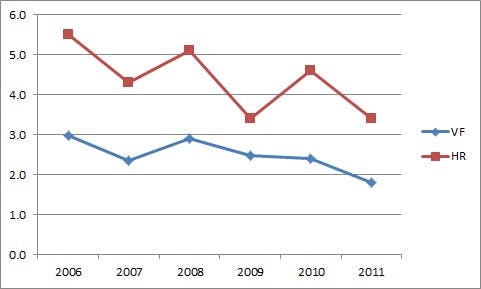

Roman Hamrlik
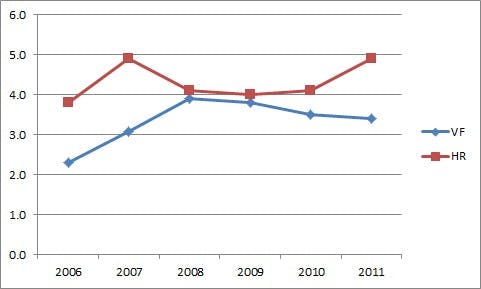

Ian White
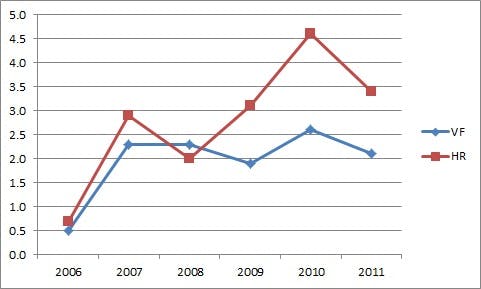

Adrian Aucoin
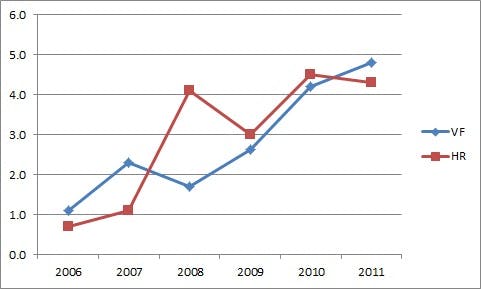

The graphs show Aucoin’s transition into a more defensive-minded blueliner, whose defense has surpassed Roman Hamrlik’s solid two-way play, and makes the distinction between them and more offensive-minded players like Dion Phaneuf and Ian White, whose defensive play is consistently reasonable.
The new approach works a little less well with more defense-oriented players like Robyn Regehr, Steve Staios and Jim Vandermeer, but isn’t really that much worse. Actually, the system really blew it with Steve Staios, but in its defense the Edmonton Oilers had virtually no defensive options those two seasons and gave him a lot of ice-time he probably didn’t earn with his defensive play.
Robyn Regehr
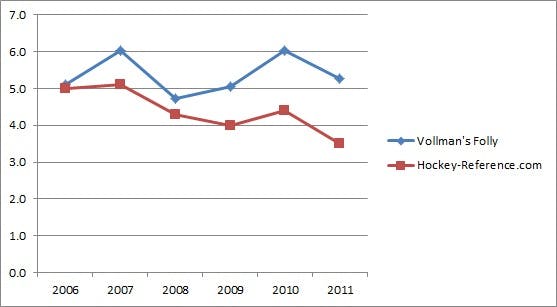

Steve Staios
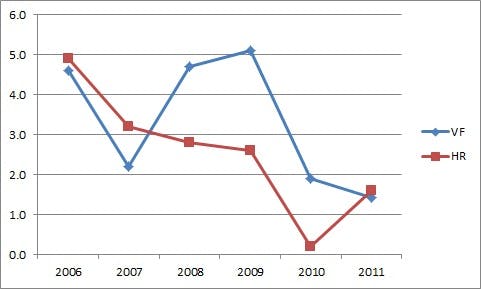

Jim Vandermeer

Finally there are defensemen like Jordan Leopold and Andrew Ference who are a little tougher to pigeon-hole. Either way the two approaches don’t yield spectacularly different results, and a solid case could be made for either trend line.
Jordan Leopold


Andrew Ference


The Verdict
Evaluating a team’s defense as a whole doesn’t seem to be a major problem, but assigning credit to the individual players obviously has been, which is why we get silly results like Anton Babchuk being equivalent to Robyn Regehr, and the subsequent lack of credibility in the eyes of the common fan.
While we didn’t intend to propose a perfect solution meant to completely restore everyone’s faith in objective statistical analysis, we at least demonstrated that there is clearly a path that heads in the right direction.
Even with a quick-and-dirty approach to figuring out how much of a player’s ice-time is spent playing a defensive role and assigning credit accordingly we demonstrated that you can avoid the silly Babchuk/Regehr results without significantly affecting the more accurate results scored with everybody else.
I look forward to your comments on these results, and if there’s interest I can compute them for the Flames current defenders, too.
Recent articles from Robert Vollman




